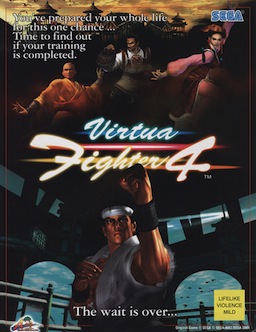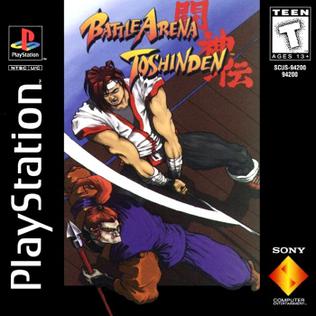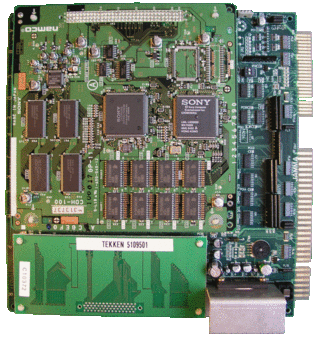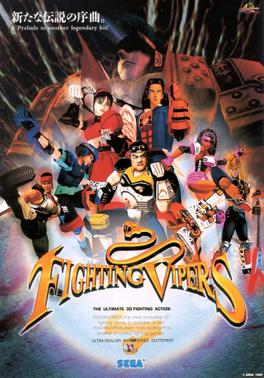
The Sega Saturn is a home video game console developed by Sega and released on November 22, 1994, in Japan, May 11, 1995, in North America, and July 8, 1995, in Europe. Part of the fifth generation of video game consoles, it is the successor to the successful Genesis. The Saturn has a dual-CPU architecture and eight processors. Its games are in CD-ROM format, including several ports of arcade games and original games.
The fighting game genre of video games involves combat between multiple characters, often one-on-one battles. Fighting game combat often features mechanics such as blocking, grappling, counter-attacking, and chaining attacks together into "combos". Characters generally engage hand-to-hand combat, often with martial arts, but some may include weaponry. Battles are usually set in a fixed-size arena along a two-dimensional plane, where characters navigate the plane horizontally by walking or dashing, and vertically by jumping. Some games allow limited movement in 3D space, such as Tekken, while some are set in fully three-dimensional environments without restricting characters' movement, such as Power Stone and Naruto: Ultimate Ninja Storm; these are sometimes referred to as "3D arena" fighting games.

Virtua Fighter is a fighting game created for the Sega Model 1 arcade platform by AM2, a development group within Sega, headed by Yu Suzuki. An early prototype version was location tested in Japan by August 1993, before the complete game was released worldwide in December 1993. It was the first arcade fighting game to feature fully 3D polygon graphics. The game was ported to Sega Saturn as a global launch title in 1994 and 1995, and also received a port to the Sega 32X.

Tobal No. 1 is a 1996 fighting video game developed by DreamFactory and published by Square for the PlayStation. The game was DreamFactory's first release, as well as Square's first release on the CD-based console. Tobal No. 1 marks Square's first incursion into the fighting game genre, although an adventure-like quest mode is also part of the game.

Yu Suzuki is a Japanese game designer, producer, programmer, and engineer, who headed Sega's AM2 team for 18 years. Considered one of the first auteurs of video games, he has been responsible for a number of Sega's arcade hits, including three-dimensional sprite-scaling games that used "taikan" motion simulator arcade cabinets, such as Hang-On, Space Harrier, Out Run and After Burner, and pioneering polygonal 3D games such as Virtua Racing and Virtua Fighter, which are some of the games besides others from rival companies during that era credited with popularizing 3D graphics in video games; as well as the critically acclaimed Shenmue series. As a hardware engineer, he led the development of various arcade system boards, including the Sega Space Harrier, Model 1, Model 2 and Model 3, and was involved in the technical development of the Dreamcast console and its corresponding NAOMI arcade hardware.

Virtua Fighter 4 is a 2001 fighting game by Sega. It is the fourth game installment in the Virtua Fighter series. It was first released in arcades on the NAOMI 2 board followed by a console port as well as Virtua Fighter 4: Evolution on the PlayStation 2 under the budget-priced "Greatest Hits" label in 2002 and 2003, respectively.

Battle Arena Toshinden, released as Toh Shin Den in Japan, is a 1995 fighting video game developed by Tamsoft and published by Takara for the PlayStation. It was one of the first fighting games, after Virtua Fighter on arcade and console, to boast polygonal characters in a 3D environment, and features a sidestep maneuver which is credited for taking the genre into "true 3D."

Sega AM Research & Development No. 2, previously known as SEGA-AM2 Co., Ltd., is a video game development team within the Japanese multinational video game developer Sega. Yu Suzuki, who had previously developed arcade games for Sega including Hang-On and Out Run, was the first manager of the department.

Virtua Cop 2 is a light gun shooter arcade game, released in 1995 and developed internally at Sega by their AM2 studio. It was ported to the Sega Saturn in 1996, PC in 1997, and Sega Dreamcast in 2000. It was bundled with Virtua Cop in Virtua Cop: Elite Edition for PlayStation 2 in 2002.

The Namco System 11 is a 32-bit arcade system board developed jointly by Namco and Sony Computer Entertainment. Released in 1994, the System 11 is based on a prototype of the PlayStation, Sony's first home video game console, using a 512 KB operating system and several custom processors. The Namco System 12 is an upgraded version of the System 11 that was released in 1996, featuring faster processing power.

Virtua Striker is a series of association football sports video games released by Sega for arcades. Originally developed by Sega AM2 from 1994 to 1999, the series moved to Amusement Vision with Virtua Striker 3, but it later moved to Sega Sports Design R&D Dept. with Virtua Striker 4.

Virtua Fighter 2 is a 1994 fighting video game by Sega. It is the sequel to Virtua Fighter (1993), and the second game in the Virtua Fighter series. Created by Sega's Yu Suzuki-headed AM2 team, it was designed on the purpose-made Sega Model 2 hardware which provided a significant upgrade in graphical capabilities. Following its release on the arcades, Virtua Fighter 2 was ported to the Sega Saturn home console in November 1995, while ports for some other platforms appeared later.

Fighting Vipers is a 1995 fighting video game developed by Sega AM2. A 3D fighter, it uses the same game engine as AM2's Virtua Fighter 2 (1994) but features enclosed arenas and an armor mechanic, and was targeted more towards Western audiences, using a U.S. setting and more freeform styles of martial arts.
DreamFactory Co., Ltd. is a Japanese video game developer founded in 1995, based out of Tokyo. They are best known for developing fighting and beat 'em up games, such as the Tobal No. 1 fighting game series and the high-profile PlayStation 2 title The Bouncer, both developed under Square Co. The company's chairman, Seiichi Ishii, is an industry veteran who served as an early designer and director for two fighting game franchises: Virtua Fighter and Tekken.

Virtua Fighter 5 is the fifth installment in Sega's Virtua Fighter series of arcade fighting games. The original version was released in July 2006 on the Sega Lindbergh arcade system board with a number of updates before home ports were released for PlayStation 3 and Xbox 360 in 2007. The first major update was Virtua Fighter 5 R (2008), followed by Virtua Fighter 5 Final Showdown (2010), with the latter ported to home systems in 2012. A remastered version of Final Showdown was released in 2021 as Virtua Fighter 5 Ultimate Showdown on PlayStation 4 and as Virtua Fighter esports on Japanese arcades.

Virtua Fighter 3 is a 1996 fighting game developed and published by Sega, the sequel to 1994's Virtua Fighter 2 as part of the Virtua Fighter series. Released originally on arcades, an updated version named Virtua Fighter 3tb was later made with the addition of team battles. This updated version of the game was ported to the Dreamcast home console in 1998 after the cancellation of a Sega Saturn port.
Virtua Fighter is a series of fighting games created by Sega AM2 and designer Yu Suzuki. The original Virtua Fighter was released in December 1993 and has received four main sequels and several spin-offs. The highly influential first Virtua Fighter game is widely recognized as the first 3D fighting game released. The latest mainline release was Virtua Fighter 5 in 2006; this version has since been continuously updated.

Sarah Bryant is a character in the Virtua Fighter series of fighting games by Sega. She is a college student from San Francisco, California, who debuted in the original Virtua Fighter, brainwashed to try and kill her brother, and later tries to surpass him while seeking to take down the organization responsible. She has appeared in every game in the series including spinoff titles, and made several guest appearances in other games, notably in Tecmo Koei's Dead or Alive 5 as a playable character. In addition, she has been featured in various print media, as well as the Virtua Fighter anime.

Tekken (鉄拳) is a 1994 fighting game developed and published by Namco. It was originally released on arcades, then ported to the PlayStation home console in 1995. One of the earliest 3D polygon-based games of the genre, Tekken was Namco's answer to Virtua Fighter and was designed by Seiichi Ishii, who himself was also Virtua Fighter's designer when he worked at Sega previously. The game was developed on the purpose-built low-cost System 11 board, based on PlayStation hardware.
Eric Kelso is an American voice actor, director, presenter and producer currently based in Tokyo, Japan.















